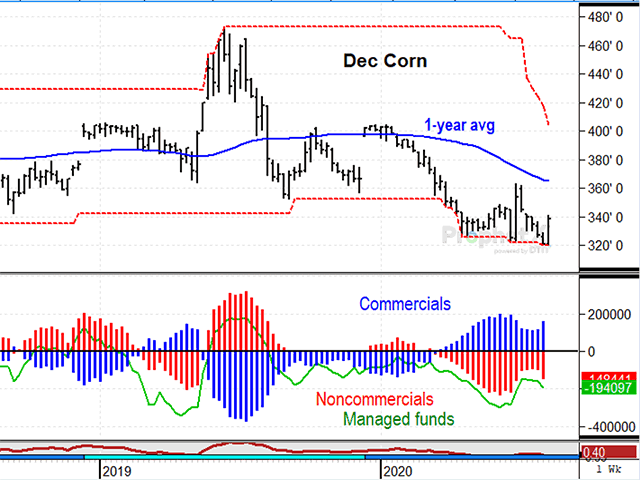Todd's Take
Corn Finds a Bullish Trigger
The old saying, "it is often darkest before the dawn" has rung true twice this year for corn, and I have to shake my head at how these things happen. The first happened around the time of USDA's Acreage report at the end of June. Planting had gone remarkably well and big states like Iowa and Minnesota finished early.
Trade estimates were looking for a corn planting somewhere between 94.0 million and 96.0 million acres (ma) and the guesses were reasonable. There was even a concern the 97.3-ma record from 2012 was within reach. Chances for an extremely bearish 16.0 billion-bushel (bb) corn crop looked very possible.
But on report day, when the clock ticked 11 a.m. CDT, USDA said only 92.0 ma of corn were planted -- a bullish surprise that no one expected. I was skeptical at the time but was relieved to see this week's crop acreage data from the Farm Service Agency (FSA). FSA reported 5.37 million prevented acres of corn, the second most on record and a plausible explanation for USDA's low planting estimate.
In the interest of fairness, I often criticize USDA when I feel they do the public a disservice. In this case, the prevented-planting data and corresponding low planting estimate was an example of how USDA helped us have a more accurate understanding. Without those reports, we would probably still be penciling in 95.0 million corn acres.
The other darkest before the dawn moment for corn prices happened this week. I found no joy in writing the preview for Wednesday's World Agricultural Supply and Demand Estimates (WASDE) report, as the market was anticipating higher crop estimates for both corn and soybeans. With crop ratings high and much of the Midwest receiving timely rains when needed, I couldn't disagree with the conclusion that dry weather in western Iowa wasn't enough to prevent a bearish future for corn prices.
P[L1] D[0x0] M[300x250] OOP[F] ADUNIT[] T[]
Sure enough, the WASDE report was bearish for both corn and soybeans. A record corn crop estimate of 15.28 bb and the highest estimate of U.S. ending corn stocks since the 1980s was clearly bearish. USDA lowered its average farm price estimate to $3.10. Historical cash corn prices for the 19% ending stocks-to-use ratio pointed to cash prices in the upper $2s. As you probably know by now, December corn finished up 3 3/4 cents Wednesday.
Had that been the end of the story, we wouldn't be talking about corn now, but on Thursday things got more interesting. All of a sudden, the conveyer belt of timely rains that had been showing up for everyone but western Iowa stopped. The extended forecast turned dry and even the seven-day forecast doesn't show much chance for moisture after Friday. It turns out there still is a weather risk for row crops, and on Thursday, December corn jumped up 11 1/2 cents and November soybeans were up 16 1/2 cents.
At this point, I still have to agree the numbers are overwhelmingly bearish for corn, even with the dry forecast, but the story is not over yet. Because managed futures funds were complacently net-short 194,097 contracts as of Aug. 4, we do know that they are now under pressure to liquidate and that gives corn prices a little bullish hope in a tough bearish market.
Monday's severe wind damage through the central Midwest, the ill-fated derecho, is another part of corn's bullish potential this week, but there is not enough evidence for a confident estimate at this time.
DTN Editor in Chief Greg Horstmeier explained an effort Thursday with satellite services provided by Gro Intelligence: https://www.dtnpf.com/…
As Horstmeier explained, possible corn losses in the worst hit counties of Iowa, Illinois and Indiana totaled nearly 400 mb. However, none of us can say yet how much corn was bent versus broke, and how much corn will be able to suffer through with a decent yield. It will take time, and that adds another layer of uncertainty to help keep the funds up at night.
On the bearish side, this week's DTN/Progressive Farmer Digital Yield Tour, powered by Gro Intelligence, has been tossing out some pretty high state yield estimates for corn and soybeans. National yield estimates for both crops will be announced on DTN Friday afternoon and will add more important pieces to the puzzle.
As bearish as 2020 has been, especially for corn prices, I always try to explain that markets are people and people are emotional. Even during times when USDA estimates look especially bearish, surprises can happen and those surprises are often some of the best selling opportunities a producer will get.
I don't know how far this rally will go, but the bullish dynamic is in motion and how funds react is an important part. The July high of $3.63 in December corn offers a target and a potential source of resistance, should prices get that high. The rest is up to the weather.
Todd Hultman can be reached at Todd.Hultman@dtn.com
Follow him on Twitter @ToddHultman
(c) Copyright 2020 DTN, LLC. All rights reserved.




